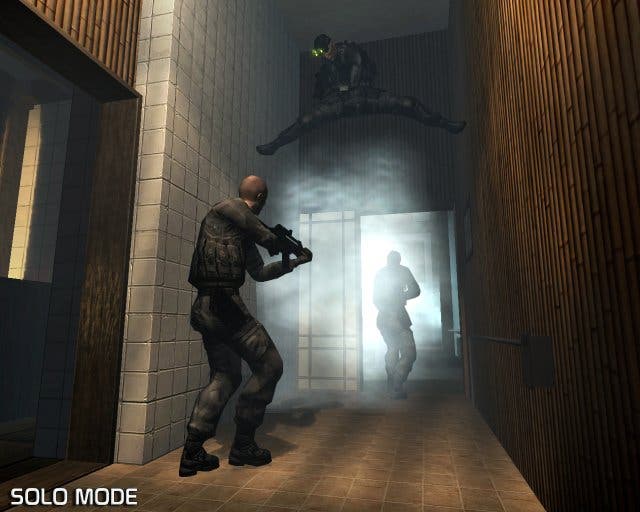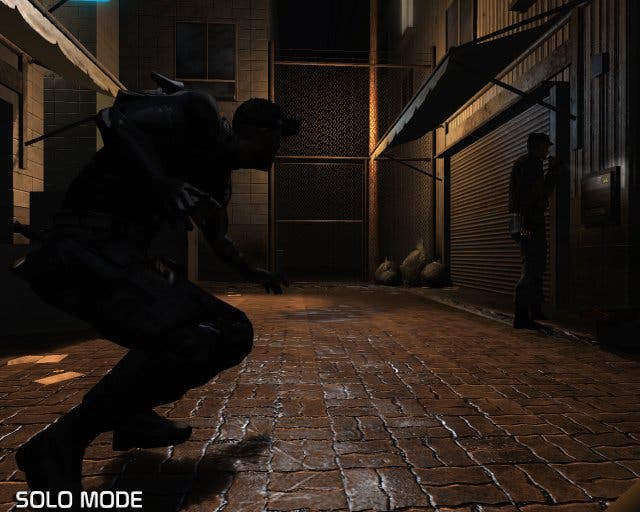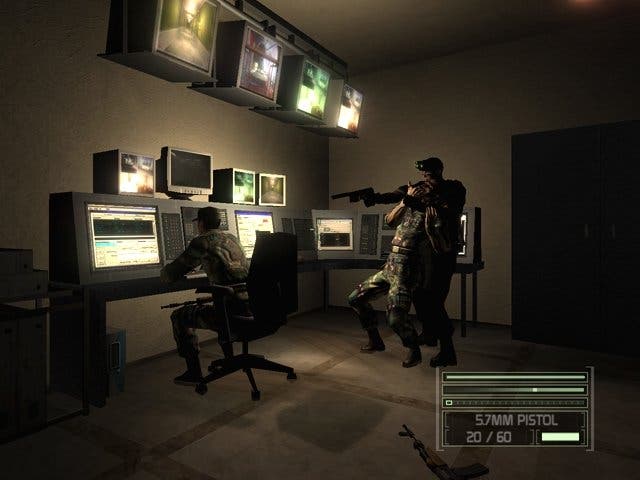Splinter Cell: Chaos Theory
We go hands on with the latest build of Ubisoft's stealth action blockbuster.
You know you've been playing too much Splinter Cell when you switch your lights off at home and expect to nod your head forward and activate your night vision. Oh dear. This certainly happened after finishing Pandora Tomorrow, and we're fully expecting similar after-effects this time around, especially given the high hopes we have for Chaos Theory, the third Sam Fisher adventure to hit in little over two years.
Two years? Three games? Isn't that pushing it a little? Well, obviously, but it's not quite as cut and dried as that. As close observers will have long since realised, Pandora Tomorrow was an opportunistic filler release designed and coded over in Shanghai while the Montreal Studio busied themselves with the 'proper' sequel - Chaos Theory. Except Pandora Tomorrow was so good, and had such a great two-on-two multiplayer mode that Ubi appeared to be content to treat it as a sequel anyway. And why not? You could barely see the join.
Stopgap

Nevertheless, as good as Pandora Tomorrow evidently was, it didn't feel like a true sequel should. It just felt like more missions with the same engine (plus multiplayer from the Paris studio, confusingly with an entirely different engine). But sod it. Most of us were happy to lap it up anyway. That doesn't mean we're any less excited about Chaos Theory, either. We still have it in our mind's eye as the true progression for the series, and so when a playable build finally showed up this week it didn't exactly take us long to get going with it.
Kicking off in a level known as 'Lighthouse', we join Fisher on a calm night on a rocky beach under a full moon. The ocean gently laps the shore, and with the exception of a couple of abandoned boats there's little choice but to climb up some nearby rocks and head for a narrow cave entrance. Squeezing through a tight gap gains entrance to a dimly lit cave complex illuminated via the shafts of moonlight in the crumbling cave roof and the odd naked light bulb powered by a rattling generator nearby.
Grab and smash

As ever, dealing with the many patrolling guards is the name of the game, and at this early stage of the game they typically stroll around on their own giving you the perfect opportunity to sneak up behind them and grab them undetected. Currently you get the choice of interrogating them (if they've got anything to say at all, which some of them don't) or dispatching them in one of two ways; left trigger basically squeezes the life out of them, while right cracks them over the bonce and knocks them unconscious. Failing that you could shoot them beforehand and risk sending your noise meter off the scale and attract attention, but it's somehow more fun this way.
Early on it seems more or less designed to let you get away with being a bit slack - presumably not to alienate newcomers. But to old hands it'll clearly be evident what the deal is; lots of solo patrols that are easy to get rid of, very unlikely to be discovered by some alarm-raising git, and who don't spend too long looking for the source of the disturbance even when they see a black shape slink into the gloom. It's plain to see that Ubisoft wants to make Splinter Cell a more inclusive experience, perhaps only too aware that previous Splinter Cells were often damned unforgiving right from the start.
To make things even more manageable, there's now a quicksave option, so no longer do we have to sweat it out slogging it to the next checkpoint. This is both a good and a bad thing; no one wants to be beaten over the head having to repeat the same sections over and over again, or to end up having to play the final third of the level with almost no health or ammo and so on, but it does make progress just that much easier. As a result it's less stressful as you find yourself scoping out levels a lot more, taking a lot more risks, and easily being able to load in your last save when something inevitably messes up. We're still undecided whether this is a good thing or not, but we guess the ultimate answer is that you don't have to use it. But dammit, it's too tempting not to [Lord help you if you ever have to give anything up -Tom]. Gah. Has Ubisoft solved one bugbear but lost half the tension that went with playing the game in the first place? Maybe. The burden of temptation is on you now.
I believe in a thing called dark

But we digress. As you work your way through the cave network it's once again paramount to kill the lights however you feel like it. Shoot them out, explode oil lamps, shatter light bulbs, or maybe even pierce power generators to render them useless. Darkness is your friend and without it you're toast; the sooner you realise this (and old hands will be all too aware of the benefits) the easier the game will become.
As we've seen in some of the previous demonstrations, Sam has a bunch of new context-sensitive moves that add greatly to your stealth manoeuvres. Chief of these is the glorious new ability to stealthily open doors. Rather than simply blunder in, you can scope them out as usual with your handy fibre optic cable, then slo-o-o-o-wly open any door at your own pace and creep through undetected with ease. Other situations prove equally rewarding, letting Fisher enter crawl spaces or slice open tent doors, for example. You'll never go camping again.
As with Pandora Tomorrow, the ability to whistle to attract attention proves as useful as it is irritating - mainly as it's still mapped right next to your weapon select button, and if you're as ham-fisted as us you'll accidentally hit it at the most inappropriate times. Like when you're crouched right in front of two machinegun-wielding guards hungry for killing.
The main aim

Elsewhere, being able to change which hand you're aiming your gun with dynamically (by clicking the right stick while aiming) is a huge boon, allowing you to approach doorways and inch round corners far more effectively than ever before, and the sense is that the controls and level of interactivity have improved a notch. Someone's evidently been listening.
On a visual level it's evident that somehow things have been improved even further, with subtle normal mapping techniques giving surfaces textures much more depth as well as a certain reflective quality. Given that the series is already among the best-looking games around, to report on improvements shows what a capable machine the Xbox really is when developers really try, and with the usual attention to character model detail, sublime animation, incredible use of lighting, a consistently smooth frame rate and a general all-round high quality of level design it's hard to imagine it could have been done much better. Even those dreaded jaggies around Fisher's head mounted lights have finally gone. Hurrah.
Other small improvements we noticed include a much slicker set of mission briefings which gives a much greater impression of your goals and the background behind them, although it's still far weaker in terms of grandiose scene-setting cinematics than MGS. Arguably though it makes up for slightly crap cut-scenes by simply letting you get on with actually playing the game as opposed to bogging the player down with narrative they possibly won't care about. One day Splinter Cell will go all Hollywood on us and we'll probably whinge about that too. Ubisoft: just accept you can't win, ever.
An easy start

Having taken out a steady succession of guards in fairly straightforward fashion on the Lighthouse level that took us into Castle wine cellar, a grisly torture dungeon, various courtyards, past an old artillery battery and eventually onto the lighthouse itself for extraction it seemed pretty clear to us that the main aim is to keep things clear and manageable in the early stages. It's an ostensibly linear experience throughout - save for the odd opportunity to take an alternative route to the same place - but always focused and a lot of fun.
Moving onto the Cargo level, this time Fisher finds himself aboard a rickety old ship, full of gas leaks, flooded rooms and trigger-happy fools that would seemingly rather blow the whole vessel to smithereens than let you live. Again, the task at hand is very much familiar ground for the series - although made instantly more difficult by having light fixtures too well protected to shoot. With matters becoming a touch more taxing it's a better game for it, and it's clear to us that Ubisoft intends to introduce a more gradual learning curve than before, which can only be a good thing for most players. The last thing any of us want is for it to be dumbed down to a fault.
With much to see, we came away from our evening of Chaos Theory more than happy to reacquaint ourselves with the series and indulge in an experience that has a feel of having been more thoughtfully designed - if a little gentler. It's obvious that Ubi has adopted an "if it ain't broke" philosophy to the single-player game, tweaked a few bothersome elements and improved the visuals while sticking to the principals that have made it a firm favourite.
Will it Cell?
Naturally in a game like this a lot can change between now and the final product; the AI balancing for a start, not to mention the online multiplayer element which we look forward to getting to grips with when the full boxed version lands in the run up to its 1st April launch date. But, pleasingly, even at this stage it's looking like a highly promising effort that series aficionados will love and sceptics may finally decide to get on board with.


